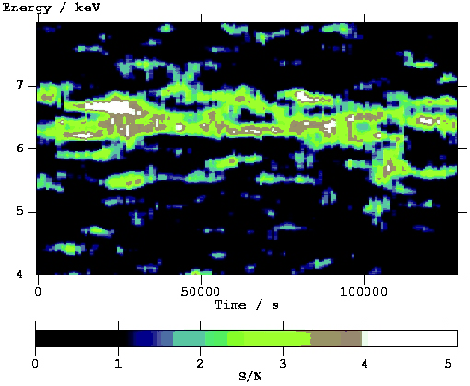Since 2004 I have worked with Jane Turner (UMBC/NASA-GSFC), James Reeves (Keele), Steve Kraemer (Catholic/NASA-GSFC) and Ian George (UMBC/NASA-GSFC) on analysis of X-ray emission from bright nearby active galaxies, based on observations with the XMM-Newton, Suzaku and Chandra X-ray observatories. In 2004-5 we developed new analysis methods that have enabled us to detect possible evidence for motion of material in orbit around the central supermassive black hole in the nearby active galaxy (AGN) Markarian 766, and are applying these techniques to more observations of nearby AGN.

|
This plot shows the variation in received flux as a function of photon energy (y-axis, in units of keV) and time (x-axis, in units of seconds) from the 2001 observation of nearby active galaxy Markarian 766. The colour scale indicates the signal-to-noise ratio of the excess emission above the continuum. The excess emission seen here comes from electronic transitions in highly ionised iron (Fe 24+). The variation of the photon energy with time appears complex, and may be evidence for orbital motion of material in the accretion disc (for more details see the bibliography). The calculated likely black hole mass lies in the range 0.5 - 50 million solar masses, within a radius of about 4 A.U. (astronomical units, the distance between the Earth and the Sun) - a scale size comparable to the orbit of Jupiter in our solar system! |
|
Currently interest has focused on the effects of absorption on our view of the inner regions of the nucleus, and whether we can detect X-ray spectral signatures of winds outflowing from the accretion disc. We see absorption lines from species such as highly-ionised iron (Fe 24+) with outflow velocities of 100s, 1000s or even 30,000 km/sec in various nearby AGN. |

|

|
One example of this is shown above, an X-ray spectrum of NGC 3516 from the Chandra mission (Turner et al. in preparation) showing an almost "P-Cygni"-like blue-shifted absorption profile, indicative of the joint effects of emission and absorption from a region that is likely close to the black hole (see schematic diagram, left, from Turner et al. (2007)). New observations and analysis are in progress. |